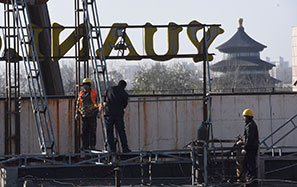Silk Road should take the green route
Government and corporate strategies must dovetail with environmental protection as big projects are built
The first wave of initiatives on the Silk Road Economic Belt are mostly construction projects to build enormous networks of road and rail transport lines, energy pipelines and industrial corridors. They follow on the heels of several cargo fast lanes between Chinese inland industrial powerhouses and Western Europe, which have been operational in the past two years, such as Chongqing-Antwerp, Zhengzhou-Hamburg and Yiwu-Madrid.
Given the growing commitment by the Chinese government to rebuild the ancient Silk Road, there is rising interest in Asia and Europe for its potential contribution to economic and industrial development but also serious concerns about its environmental feasibility and consequences.
Land connections provide better connectivity among Silk Road countries, but infrastructure projects require huge expanses of land which may reduce forest cover, vegetation, fields and farms, and cause soil and water pollution. Also, land transportation, using vehicles and trains, may substantially increase air and noise pollution.
Another concern of the Western media is the possible transfer of China's industrial overcapacity to countries along Silk Road and its environmental consequence. The relocation of labor-intensive and manufacturing activities could emerge as a major contribution to pollution migration due to the intensification of human activities.
Environmental issues, as reflected in public opinion, government policy and corporate strategy, are increasingly considered key issues for sustainable and inclusive development. They are also of crucial importance in the implementation of the Silk Road Economic Belt, especially in the context of rising concern about climate change.
From the government policy perspective, the deterioration of environmental systems may affect ecosystems, and increase economic and social costs and risks, which would adversely affect social and economic development as well as living conditions. Facing such concerns, the Chinese government has agreed to share its experience in developing environmental sustainability and green processes and suggested collaboration in nonfossil energy sectors - such as hydro, nuclear, wind and solar power - and in emerging industries, including new-generation information technology, biotechnology, new-energy technology and new materials. This is also a priority in China's 13th Five-Year Plan (2016-20).
In switching to inclusive and balanced development, there is certainly a need for companies to "go green", keeping in mind the concerns about environmental implications of consumer and investment choices. Therefore, the idea of building a "Green Silk Road" is in harmony with the corporate strategy of multinational enterprises, which may play a key role in driving innovation in both technological transformation and business model adaptation, such as energy transformation, carbon emissions reduction, energy efficiency solutions, green industrial parks, green supply chains and green factories.
Chinese multinational companies have already showed strong interest and commitment to green technologies and green business models when setting up operations in Europe. Recently, BYD made a significant breakthrough in green technology by introducing its zero-emissions electric buses in London.
Green business models also have been adopted by a number of large Chinese enterprises on their way to becoming global corporate citizens. For instance, Huawei has developed a green communication business model to ensure energy efficiency and emissions reductions along the product life cycle, encompassing green sites, green equipment rooms, green transmission, green energy and green packaging.
The learning process generated by the growing cooperation between Chinese and European companies is crucial for the "green growth" of Chinese and European industries. Yet when considering the cooperation between Chinese and European industries for green growth in the context of the Silk Road Economic Belt, China and European countries need to look at policymaking in a broader perspective. The institutional "connectivity" has to be efficiently established for better economic and industrial policy coordination and regional cooperation among Silk Road countries, while links between leading multinational enterprises and domestic small and medium-sized enterprises should be promoted along the global value chain for inclusive development.
The author is professor and director of Neoma Business Confucius Institute based in Rouen, France. The views do not necessarily reflect those of China Daily.


















